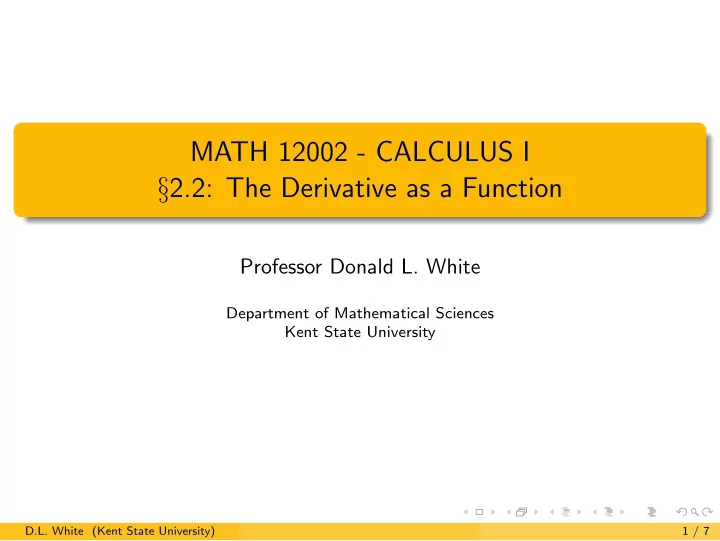

MATH 12002 - CALCULUS I § 2.2: The Derivative as a Function Professor Donald L. White Department of Mathematical Sciences Kent State University D.L. White (Kent State University) 1 / 7
The Derivative Function Definition Let y = f ( x ) be a function. The derivative (function) of f is the function f ′ ( x ) defined by f ( x + h ) − f ( x ) f ′ ( x ) = lim h . h → 0 The domain of f ′ is the set of all numbers x in the domain of f such that this limit exists. Note: There are several other standard notations for the derivative of y = f ( x ) (or more precisely, the derivative of f with respect to x ), including f ′ ( x ) = y ′ = dy dx = df dx = d dx f ( x ) . The notation dy dx is called Leibniz notation . D.L. White (Kent State University) 2 / 7
Examples Example Find the derivative of f ( x ) = 5 x 2 + 3 x. Solution By definition, f ( x + h ) − f ( x ) f ′ ( x ) = lim h h → 0 [5( x + h ) 2 + 3( x + h )] − [5 x 2 + 3 x ] = lim h h → 0 [5 x 2 + 10 xh + 5 h 2 + 3 x + 3 h ] − [5 x 2 + 3 x ] = lim h h → 0 5 x 2 + 10 xh + 5 h 2 + 3 x + 3 h − 5 x 2 − 3 x = lim h h → 0 [Continued → ] D.L. White (Kent State University) 3 / 7
Examples Solution [continued] 5 x 2 + 10 xh + 5 h 2 + 3 x + 3 h − 5 x 2 − 3 x = lim h h → 0 10 xh + 5 h 2 + 3 h = lim h h → 0 h (10 x + h + 3) = lim h h → 0 = h → 0 (10 x + h + 3) , since h � = 0 , lim = 10 x + 0 + 3 = 10 x + 3 . Therefore, f ′ ( x ) = 10 x + 3 or, in Leibniz notation, d dx (5 x 2 + 3 x ) = 10 x + 3 . D.L. White (Kent State University) 4 / 7
Examples Example 1 Find the derivative of f ( x ) = x +2 and find the slope of the tangent line to f at x = 3 . Solution By definition, f ( x + h ) − f ( x ) f ′ ( x ) = lim h h → 0 1 1 x + h +2 − x +2 = lim h h → 0 x +2 x + h +2 ( x +2)( x + h +2) − ( x + h +2)( x +2) = lim h h → 0 � � ( x +2) − ( x + h +2) ( x +2)( x + h +2) = lim [Continued → ] h h → 0 D.L. White (Kent State University) 5 / 7
Examples Solution [continued] � � ( x +2) − ( x + h +2) ( x +2)( x + h +2) = lim h h → 0 x + 2 − x − h − 2 = lim ( x + 2)( x + h + 2) · h h → 0 − h = lim ( x + 2)( x + h + 2) · h h → 0 − 1 = lim ( x + 2)( x + h + 2) , since h � = 0 , h → 0 − 1 1 = ( x + 2)( x + 0 + 2) = − ( x + 2) 2 . [Continued → ] D.L. White (Kent State University) 6 / 7
Examples Solution [continued] We have 1 f ′ ( x ) = − ( x + 2) 2 , and so the slope of the tangent line at x = 3 is (3 + 2) 2 = − 1 1 5 2 = − 1 f ′ (3) = − 25 . D.L. White (Kent State University) 7 / 7
Recommend
More recommend